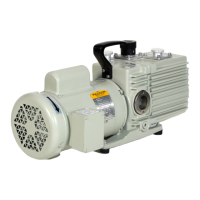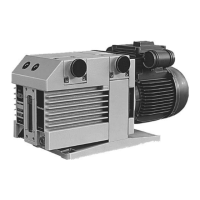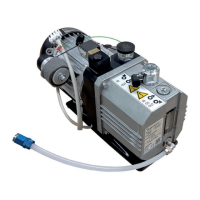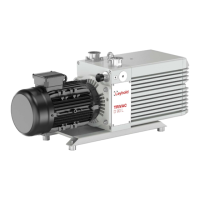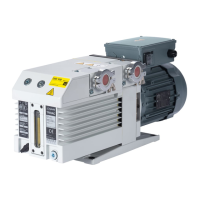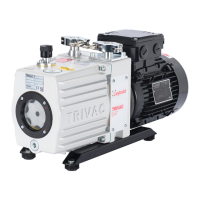install an exhaust line with a smaller
10
than the exhaust port or have restrictions
valves in the exhaust
line during operation. Such restrictions reduce the pumping speed
damage the oil seals or cause a dangerous overpressure in the pump.
Using the KF clamp ring
and
the centering ring with
an
O-ring
(7),
make
one
of
the following
connections
to
the exhaust port (6).
a.
If
practicable, install the exhaust line at a slightly descending angle
to
prevent condensate
from flowing back into the pump
and
contaminating the pump fluid. Attach a drain
valve
at the lowest
point
in the exhaust line
to
drain
off
any condensates; then run the
exhaust
line up
to
its emission outlet. This arrangement
also
prevents particulates from
dropping back
into
the pump from the exhaust line.
b.
If
the exhaust line must
be
installed in the ascending position and the
process
gas
contains
high
levels
of
condensable vapors, connect
an
AK
condensate trap
to
the exhaust
port.
AK
traps
serve
to
collect the condensates from saturated vapors,
See
Section 1
of
our catalog
for
additional information on condensate traps.
c.
If
no exhaust line
is
connected
and
your pump
will
be
running above 1
Torr
inlet pressure,
connect
an
AF
or
SE
series
exhaust
filter
to
the exhaust
port
(6)
to
remove pump
fluid
va-
pors and smoke.
See
Section 1
of
our
catalog
for
additional information
on
exhaust filters.
5.
If the exhaust line is attached
to
a negative pressure exhaust system, adjust the negative pressure
so that pump
fluid will not
be
drawn from the pump.
3-4
MAKING THE ELECTRICAL CONNECTION
When
making the electrical connections
for
your
motor,
ensure
that
everything
is
grounded properly. Six-foot
linecords
are
supplied on all standard single-phase
60-HZ
motors
that
are
purchased through Leybold. Most
of
our
single-phase
motors
also
have
automatically
resetting
thermal
overloads.
If
the
motor
doesn't
have
a
linecord,
you
must
provide
the
correct
thermal
overloads
to
protect
the
motor.
For 3-phase motors, use the schematic diagram on the
motor
nameplate
or
in
the
junction
box
to
make the •
electrical connection.
For models with 3-phase motors, wire the solenoid valve for high or low voltage according
to the instructions on the solenoid-valve nameplate. Attach the solenoid-valve leads to any two
of
the three input
line voltage wires.
SECTION 4
ST ARTING, OPERATING, AND MAINTAINING THE PUMP
4-1
START-UP
Before starting the pump, remove the shipping wedge;
an
orange cardboard tag on the pump has instructions tor
removing the wedge. The
AC
pump models don't have a wedge or a tag. .
The motor
manufacturer
guarantees a maximum
of
six
starts
per
hour at
maximum
power. To avoid exceed-
ing
six
starts
per hour, run
the
pump continuously
and
regulate
the
vacuum in y.our system with a valve.
4-1-1
Check
the
Direction
of
Rotation
Refer
to
Section
5,
Step
F-1
to
check
the
direction
of
motor
rotation.
Looking
from
the
motor
end
of
the
pump,
the
motor
fan
should
rotate
clockwise.
If
the
fan
doesn't
rotate
in
the
correct
direction,
turn
the
pump
off
immediately
to
avoid
damaging
the
motor
or
the
pump.
4-1-2 Using
the
Gas Ballast Valve During Pump Warm-up
10
NOTE: Opening the gas ballast valve
(17)
results in
an
oil mist
in
the exhaust stream and higher pump fluid con-
sumption, operating temperature, and ultimate pressure. After closing the gas ballast valve, the pump normally
reaches ultimate pressure as soon
as
it cools
to
operating temperature.
CAUTION: PUMPING PROCESS GAS WITH A COLD VANE' PUMP CAN RESULT
IN
VAPORS CONDENSING
IN
THE PUMP FLUID.
1.
Operate the pump with tlie gas ballast valve
(17)
open (see Section 2-3-1) and the intake tube
(1)
closed for about
V2
hour while the pump is warming to operating temperature.
NOTE: If your system has a valve in the vacuum line, the intake tube
(1)
can be closed by shutting
the vacuum-line valve
during the pump warming period.
NOTE: When the pump is cold, condensation may occur in spite of the gas ballast valve being open.
2.
Open the intake tube
(1)
and/or vacuum-line valve and allow the pump to operate for a few addi-
tional minutes with the gas ballast valve
(17)
open. This will remove condensable vapors from the
system.
TRIVAC "A" Manual, Edition L
